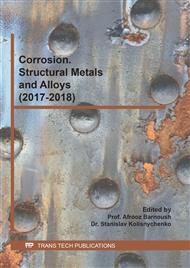p.797
p.803
p.810
p.818
p.826
p.832
p.840
p.849
p.859
Corrosion Resistance of a Gradient Surface with Cr Alloying on Low-Carbon Steel
Abstract:
As compared with the untreated one, the low-carbon steel with gradient alloying produced by impact peening showed an increase in corrosion resistance. Specifically, when the corrosion potential increased from-1061 mV to-603.5 mV, the corrosion current density decreased from 1.579×10-3 A/cm2 to 6.703×10-4 A/cm2, the capacitive arc radius increased, and there was no corrosion products viewed on the surface. The improvement in corrosion resistance could be attributed to the diffusion of Cr allowed by the large number of defects induced by the impact peening deformation. This also resulted in the formation of Fe-Cr solid solution, which helped to promote the formation of a passivation film.
Info:
Periodical:
Pages:
826-831
Citation:
Online since:
June 2017
Price:
Сopyright:
© 2017 Trans Tech Publications Ltd. All Rights Reserved
Share:
Citation:



